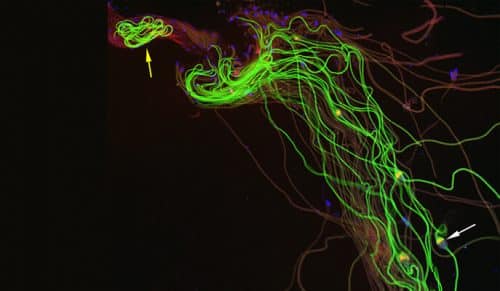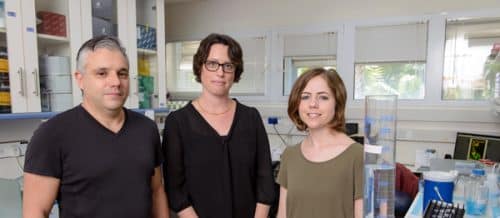The institute's scientists discovered that a "molecular machine", which activates the destructive enzymes, binds to a certain protein that inhibits its activity, thus controlling the activity of the enzymes and preventing unwanted destruction. This research may have implications for many fields, including cancer research

Is it possible to design a vase using a bulldozer? The simple answer is, of course, that it is impossible. But - it turns out - this is exactly how living cells work: destructive enzymes, called "caspases", help unwanted cells to commit suicide, but on the other hand, they sometimes also perform delicate tasks, such as remodeling the cell structure or separating connected cells. However, how do the enzymes avoid destroying all the cells and causing the cell to die?
To answer this question, Weizmann Institute of Science scientists examined a particularly delicate process: separating the sperm cells of the yeast fly from each other. In this process, the caspases break the cytoskeleton, which normally holds the sperm cells together, thus separating these cells. During the separation, the caspases also destroy the unnecessary parts of the cell, such as the cytoplasm and most of the cell organelles, and dispose of them, leaving only the structures necessary for the sperm to achieve its one and only goal - fertilization of the egg.

as which was recently reported in the scientific journal Developmental Cell, as part of the research, the (then) research student Dr. Lior Aram, and other members of the group of Prof. Eli Arma From the department of molecular genetics, an interesting discovery: a molecular machine from the "ubiquitin ligase" family (which activates the caspases) is not able to activate them alone during the separation of the sperm cells, and in order to do so it must bind to the AS-beta protein. A protein found on the surface of two organelles called mitochondria, which occupy most of the volume in the tail of the sperm, and produce the energy necessary for the sperm to reach the egg and fertilize it. In fact, this is part of a control mechanism designed to prevent the creation of destruction, or even the killing of the sperm itself, which would have been caused if all the caspases were activated at once. Thus, binding to the AS-beta protein limits the activity of caspases, and only the ubiquitin ligases that bind to this protein on the surface of the mitochondria can activate them. The active caspases move away from the mitochondria through diffusion and are dispersed in the cytoplasm, and their concentration decreases as the distance between them and the mitochondria increases. Without this control mechanism, all the caspases would be activated at once, killing the sperm or causing unwanted cell destruction.
The fact that this control is carried out using AS-beta - a protein involved in the production of energy in the cell - shows that this is probably also a quality control mechanism. It is possible that when some of the AS-beta proteins move to the surface of the mitochondria, while the other proteins participate in the production of energy inside the cell, this indicates that the metabolism in the cell has reached its required level, and that the cell is functioning properly. In this way, AS-beta ensures that the separation of the sperm cells will be carried out at the right time, and only for normal sperm cells.

Understanding the process of separating the sperm cells may shed new light on fertility problems in men, which are sometimes caused by structural deformations in the sperm. But the research may have much wider implications, for example in cancer research, since sometimes cancer cells survive by avoiding the destruction caused by caspases. In addition, it is known that the caspases carry out gentle and controlled destruction in dozens of processes that are essential to the cell, such as the creation of blood platelets necessary for blood clotting, the remodeling of the connections between nerve cells during learning, and the development of the eye lens, which becomes transparent after the caspases destroy its non-transparent parts. Further research is needed to discover the extent of AS-beta's involvement in preventing unwanted cell death in these processes.
Tsliil Brown, Carmel Braverman, Dr. Yosef Kaplan, and Dr. Liat Ravid from the Department of Molecular Genetics, and Dr. Smeder Levin-Zidman from the Department of Chemical Research Infrastructures participated in the study.

2 תגובות
An easy overview of the articles on the website from the Weizmann Institute magazine. 95% in molecular biology, as if there are no major mathematics, computer science and physics faculties there. By all accounts it will not be a homogeneous mix and if this is the attitude of the magazine to research - very not good.
One seems to get the impression that the magazine of the Weizmann Institute only writes about its life science researchers, while at the same time there are world experts in physics, mathematics and computer science. Perhaps sample articles on the subject do not come here and there are in the original. For examples: Mordechai Milgrom, creator of the MOND theory that Albenzo introduced to us in the comments, experts in condensed matter, computer science - member of the Israel and US Academies, creator of a biological programming language, experts in number theory and applied mathematics where small and other revolutions are currently being made. It was not mentioned in the biological article last week that the doctor is a mathematician. That is, a major part of his work is the development of software for calculating DNA-based traits.
The only news that comes on the subject of exact sciences is: Professor X was appointed a member of Society Y and won the Z prize.
Physics and mathematics and computer science are undergoing quite a few changes at the moment.